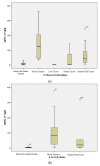Post-Mortem Analysis of Heroin Biomarkers, Morphine and Codeine in Stomach Wall Tissue in Heroin-Related Deaths
- PMID: 36006152
- PMCID: PMC9413540
- DOI: 10.3390/toxics10080473
Post-Mortem Analysis of Heroin Biomarkers, Morphine and Codeine in Stomach Wall Tissue in Heroin-Related Deaths
Abstract
Toxicological analysis of some cases can be complicated by poor sample quality caused by decomposition. Although heroin-related deaths have been researched extensively, the interpretation of toxicology findings in these cases is challenging, especially in instances where blood samples are unavailable. Thus, it is important to develop analytical methods for different sample types. In this study. a method for the quantification of 6-monoacetylmorphine, 6-acetylcodeine, morphine, and codeine in postmortem stomach wall tissue using liquid chromatography coupled with tandem mass spectrometry was developed and validated. All calibration curves prepared with the stomach wall tissue were linear and ranged from 0.5−1000 ng/g with determination coefficients of >0.99 and a lower limit of quantification of 1.0 ng/g. The coefficients of variation for within-run precision and between-run precision were <9%. Matrix effects of stomach wall tissues and their extraction recoveries were investigated and ranged from −19% to +17% and 76% to 80%, respectively. Among the 16 analyzed heroin-related death cases, 6-monoacetylmorphine, 6-acetylcodeine, morphine, and codeine were detected in 75%, 31%, 100%, and 94% of all stomach wall tissues with median concentrations of 90 ng/g, 20 ng/g, 140 ng/g, and 30 ng/g, respectively. This study provides new data on the distribution of 6-monoacetylmorphine, 6-Acetylcodeine, morphine, and codeine in postmortem stomach wall tissue and suggests the usefulness of alternative matrices for investigating heroin-related fatalities when blood samples are unavailable. In addition, the prevalence of 6-monoacetylmorphine in the stomach wall tissue was higher than that in the liver and kidney tissues.
Keywords: LC-MS/MS; forensic toxicology; opiates; opioids; postmortem; stomach wall tissue.
Conflict of interest statement
The authors have no conflict of interest to declare.
Figures



Similar articles
-
Heroin-Related Fatalities in Jeddah, Saudi Arabia, between 2008 and 2018.Toxics. 2023 Mar 6;11(3):248. doi: 10.3390/toxics11030248. Toxics. 2023. PMID: 36977013 Free PMC article.
-
Postmortem Liver and Kidney Tissue Concentrations of Heroin Biomarkers and Their Metabolites in Heroin-Related Fatalities*†.J Forensic Sci. 2020 Nov;65(6):2087-2093. doi: 10.1111/1556-4029.14537. Epub 2020 Aug 17. J Forensic Sci. 2020. PMID: 33460103
-
Postmortem Fluid Concentrations of Heroin Biomarkers and Their Metabolites.J Forensic Sci. 2020 Mar;65(2):570-579. doi: 10.1111/1556-4029.14200. Epub 2019 Sep 30. J Forensic Sci. 2020. PMID: 31566759
-
Can measurements of heroin metabolites in post-mortem matrices other than peripheral blood indicate if death was rapid or delayed?Forensic Sci Int. 2018 Sep;290:121-128. doi: 10.1016/j.forsciint.2018.06.041. Epub 2018 Jul 5. Forensic Sci Int. 2018. PMID: 30015276
-
Metabolism and metabolomics of opiates: A long way of forensic implications to unravel.J Forensic Leg Med. 2019 Feb;61:128-140. doi: 10.1016/j.jflm.2018.12.005. Epub 2018 Dec 19. J Forensic Leg Med. 2019. PMID: 30621882 Review.
Cited by
-
Challenges and insights: Methamphetamine analysis in post-mortem putrefied human tissues in a hot climate.Saudi Pharm J. 2024 Mar;32(3):101990. doi: 10.1016/j.jsps.2024.101990. Epub 2024 Feb 10. Saudi Pharm J. 2024. PMID: 38384477 Free PMC article.
-
Heroin-Related Fatalities in Jeddah, Saudi Arabia, between 2008 and 2018.Toxics. 2023 Mar 6;11(3):248. doi: 10.3390/toxics11030248. Toxics. 2023. PMID: 36977013 Free PMC article.
-
A Quantitative and Comparative Study of Heroin-Related Metabolites in Different Postmortem Fluids and Tissues.Toxics. 2025 Mar 20;13(3):229. doi: 10.3390/toxics13030229. Toxics. 2025. PMID: 40137556 Free PMC article.
References
-
- Moffat A.C., Osselton M.D., Widdop B. Clarke’s Analysis of Drugs and Poisons in Pharmaceuticals, Body Fluids and Postmortem Material. 4th ed. Pharmaceutical Press; London, UK: 2011. pp. 1225–1227.
-
- Randall B. Disposition of Toxic Drugs and Chemicals in Man. 8th ed. Biomedical Publications; Foster City, CA, USA: 2008. pp. 532–536.
LinkOut - more resources
Full Text Sources

